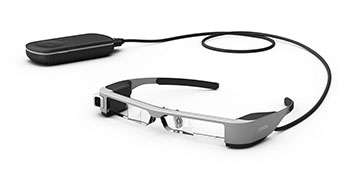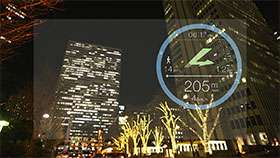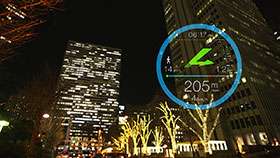Epson has today announced the third generation of its Moverio smart glasses for Augmented Reality. On display at the Mobile World Congress starting today in Barcelona, Spain, and available in selected markets from later this year, the Moverio BT-300 features Epson's own cutting edge silicon-based OLED (organic light emitting diode) digital display technology, enabling the device to be the lightest see-through binocular smart glasses on the market, and setting the new standard for augmented reality smart eyewear. The Moverio BT-300 is approximately 20% lighter than its predecessor, the BT-200.
Epson's focus on a wide range of commercial and other applications distinguishes the Moverio range from other smart glasses on the market. Developed with function at the forefront, the range has proved popular with business customers and independent software vendors (ISVs). The Moverio BT-300 continues Epson's commitment to binocular smart eyewear, real optical see-through overlay, and increased performance, both essential for professional use and opens new consumer applications opportunities.
Built with a quad core Intel Atom processor and Android OS 5.1, the BT-300 has significantly increased power to enable it to process 3D heavy content, and maintains up to six hours of battery life. Seeing and making sense of the user's environment through a 5-mega-pixel front-facing HD camera and other sensors, the smart glasses render content based on what is seen. As on previous models, and cautious of privacy standards, the device features an LED to indicate when the camera is recording.
-
BT-200 (previous model): Images and information appear inside a screen
-
BT-300 (new product): Only images and information are visible
Mr. Atsunari Tsuda, general manager responsible for Moverio said, "Moverio is distinct from other smart glasses on the market where form often supersedes function, to the detriment of the product's usability. Every design decision we make is driven by consideration for the product's ultimate usage scenarios and our Si-OLED technology opens a new world for us in binocular see-through smart eyewear development. With OLED we can take advantage of reductions in power usage and weight, and improvements in response times, HD resolution, brightness and contrast. By choosing silicon rather than glass for our base wafer we achieve an even more high-density pixel display."
Epson's Moverio range was first launched in 2011 with the BT-100, supplemented in 2014 with the BT-200, and again in 2015 with the Pro BT-2000.
A brief explanation of the BT-300 features.
A guide through various applications of how the BT-300 can be used.
With silicon OLED technology, the BT-300 will offer more powerful visual experiences.
Provided by Epson

























